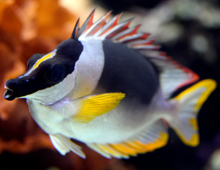Palau

Watanabe’s angelfish, Genicanthus watanabei
The ten species of swallowtail angelfish stand out among the marine angelfish family. Instead of staying close to the reef, and feeding on coral polyps and other stationary organisms, swallowtails consume plankton in the water column. While the sexes of other angelfishes are colored alike, male and female swallowtails look very different from each other. Only described to science in 1970, this species occurs off Japan and Australia, and far out into the Central Pacific, but is absent from the Indo-Pacific. Only the male has stripes.
LEARN MORE
Starki damselfish, Chrysiptera starcki
Also known as the Starck’s demoiselle, the Starki damsel, is found in the northern and southern parts of the West Pacific. These brightly colored reef dwellers are commonly kept in aquariums and are extremely hardy fish. Like other members of the family Pomacentridae, they can be very territorial, despite their small size. They can be seen fiercely defending a crevice, or hiding quietly under a coral or clam.
LEARN MORE
Magnificent foxface, Siganus magnificus
The Magnificent foxface is often considered the most attractive member of the Rabbitfish family. They are herbivorous in nature and can be seen grazing on algae throughout the day. Venomous dorsal spines and the ability to change color rapidly, help defend this coral reef dweller from predators.
LEARN MORE
Green star polyps, Pachyclavularia violacea
The Green star polyp is a hardy colonial invertebrate commonly kept in aquariums. Its characteristic bright green star-shaped polyps seem to glow in the sunlight. These tiny filter feeders can absorb organics from the water column, and like other corals, the polyps of this species also house zooxanthellae, photosynthetic algae cells which provide the coral with nutrients. A purple mat of tissue, known as a stolon, connects the multiple polyps, often covering the rock beneath it.
LEARN MORE
Moon jellyfish, Aurelia aurita
This type of jellyfish is often cultured around the world. Their sting is not powerful because they are planktivores. The flower-like pattern in the center of the disk is composed of the reproductive organs; reproduction is both sexually and asexually. This delicate invertebrate is known to survive for only a few months in the wild, but can live for years in an aquarium environment.
LEARN MORE

